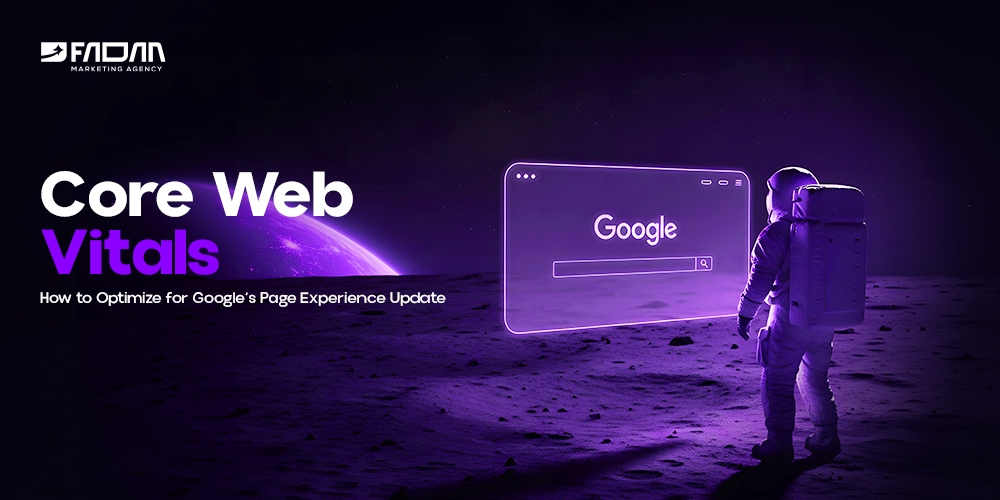In today’s competitive digital landscape, ranking high on Google isn’t just about keywords and backlinks—it’s about creating a seamless experience for your users. That’s where Core Web Vitals come in. Introduced as part of Google’s Page Experience Update, Core Web Vitals are a set of metrics that measure how users experience your website in real-time.
If you want your site to perform well in search results, understanding and optimizing for Core Web Vitals is no longer optional—it’s essential.
In this article, we’ll break down what Core Web Vitals are, why they matter for SEO, how to improve them, and how Fadaa Digital Agency helps businesses succeed by putting user experience at the heart of SEO strategy.
Core Web Vitals are a set of three specific page speed and user interaction metrics that Google uses to evaluate the overall page experience:
Largest Contentful Paint (LCP)
Measures loading performance. To provide a good user experience, LCP should occur within 2.5 seconds of when the page starts loading.
First Input Delay (FID)
Measures interactivity. A good FID is less than 100 milliseconds.
Cumulative Layout Shift (CLS)
Measures visual stability. Pages should maintain a CLS of less than 0.1 to prevent unexpected layout shifts.
These metrics give Google insight into how smooth and usable a web page feels for real users—not just how optimized it is behind the scenes.
Google officially announced that Core Web Vitals are part of its ranking algorithm as of the Page Experience Update rolled out in 2021. While content relevance still plays the biggest role in rankings, user experience is now a more powerful tie-breaker—especially in competitive SERPs.
Here’s how Core Web Vitals influence your SEO:
Better user engagement = lower bounce rates
Higher satisfaction = more conversions
Good UX = stronger trust signals
Improved scores = increased visibility in search
If you’re ignoring Core Web Vitals, you risk losing ground to competitors who are delivering faster, more stable, and more interactive sites.
Before optimizing, you need to measure. Thankfully, Google provides several tools to help you assess your site’s performance:
Google PageSpeed Insights
Gives detailed reports on LCP, FID, and CLS with suggestions for improvement.
Google Search Console (Core Web Vitals Report)
Monitors your site’s performance in real-world conditions (field data).
Lighthouse (via Chrome DevTools)
Provides lab data with diagnostics and opportunities.
Web Vitals Chrome Extension
Instantly displays metrics as you browse your site.
Start by checking key pages on your site to see where improvements are needed—then prioritize based on traffic and business value.
Let’s go over practical steps you can take to improve each of the Core Web Vitals:
Use a fast, reliable hosting provider
Optimize and compress images (use WebP format where possible)
Minimize render-blocking JavaScript and CSS
Use lazy loading for below-the-fold images
Serve assets via a CDN (Content Delivery Network)
Minimize third-party scripts
Break up long JavaScript tasks
Use browser caching
Optimize your main thread execution time
Implement web workers for non-UI blocking scripts
Always include size attributes for images and videos
Avoid dynamically injected content above existing elements
Reserve space for ads, embeds, or iframes
Use font-display: swap to prevent layout shifts from custom fonts
Improving these factors can significantly enhance both your SEO and your users’ experience, resulting in longer sessions and more conversions.
At Fadaa Digital Agency, we believe that great SEO starts with great user experience. Our technical SEO specialists and developers work together to make sure every website we build or optimize meets Google’s latest standards—including Core Web Vitals.
Here’s how Fadaa helps clients thrive in the Page Experience era:
Conducting Core Web Vitals audits using tools like Lighthouse and PageSpeed Insights
Implementing performance optimizations tailored to your CMS and tech stack
Redesigning pages with UX and speed in mind
Monitoring and maintaining Web Vitals over time to ensure long-term performance
Educating our clients on how site speed affects rankings, retention, and revenue
By focusing on Core Web Vitals, we don’t just help you rank—we help you retain, engage, and convert visitors more effectively.
Whether you're running an e-commerce store, a lead generation site, or a content-driven platform, our team can deliver a site experience that satisfies both Google and your users.
While Core Web Vitals are a big part of Google’s Page Experience Update, they’re not the only metrics that matter. Here’s what else Google looks at in its page experience signals:
Mobile-friendliness
HTTPS security
Safe browsing (no malware)
No intrusive interstitials (popups)
Combine these with fast loading, high interactivity, and visual stability—and you’ve got a winning SEO formula for 2025 and beyond.
The future of SEO is not just about what you say—it’s about how you deliver it. That’s why Core Web Vitals are so important. They reflect how real users perceive your website’s speed, stability, and responsiveness—and those factors now directly impact your search visibility.
To stay competitive, you need more than good content and backlinks. You need a site that loads fast, responds quickly, and feels smooth.
And that’s exactly what Fadaa Digital Agency helps you achieve.
 July 13, 2025 - BY Admin
July 13, 2025 - BY Admin